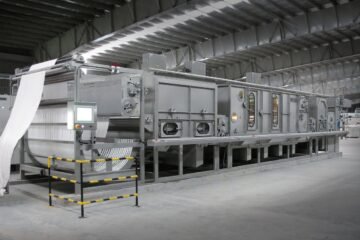Mercerising:
This process, commonly used on cotton yarns and fabrics, enhances fabric luster, improves its ability to absorb moisture, and covers imperfections like dead cotton. It also increases dimensional stability and boosts dyeing efficiency. The treatment involves using caustic soda, which causes the fibers to contract and swell, making them more translucent. This change in the fibers’ shape—first from bean-like to elliptical, and then circular—improves the reflection of light, leading to a more lustrous appearance. While the tensile strength of the fibers increases, their flexibility and twist resistance decrease.
Typically, this treatment is done under tension using caustic soda at concentrations of 28°-30° Baumé (around 270-330 g/L). If the concentration is below 24° Baumé, the process is called causticization, which is mainly intended to improve dye penetration into the fabric. The caustic solution is kept at a temperature between 15-20°C, and wetting agents are added to ensure even absorption. After the treatment, the alkalinity is immediately neutralized with a diluted acid solution. During this process, a chemical transformation occurs where alkaline cellulose is formed, followed by hydrocellulose after repeated washing, which makes the fabric more reactive than untreated cotton.
Cotton undergoes shrinkage when wet, so tension must be maintained to prevent a fuzzy or woolen appearance. Mercerizing can be done on yarns, fabrics, or knitted goods, whether they are open or in tubular form. Yarns often undergo singeing before mercerizing to remove fuzz and loose fibers that could affect the luster.

For woven fabrics, two different machines are used:
- Chain Mercerizing: This process provides excellent luster due to precise tension control, but it operates slowly and lacks flexibility when the fabric width changes.
- Cylinder Mercerizing: Faster and more compact, this method prevents the fabric from shrinking by drawing it onto cylinders, which maintain tension. Cylinder mercerizing is also suitable for flat knits.
For tubular knitted fabrics, mercerizing is done using a padding mangle. After wetting, the fabric’s width is controlled by an adjustable ring spreader, while the length is regulated by slowing down the fabric before the final squeezing. The sodium hydroxide concentration is gradually reduced to about 4° Baumé using a circular shower, and the fabric is then washed, neutralized, and rinsed.
A typical mercerizing process for tubular knitted fabrics includes:
- A detwisting unit to remove fabric twists during feeding
- Water and sodium hydroxide troughs to supply the necessary chemicals
- A swelling unit with rollers to manage fabric tension
- Four washing units with varying temperatures and widths to ensure thorough cleaning
- A neutralizing padder, where acetic acid is used at 70°C to neutralize the fabric before final rinsing
In addition to caustic soda, liquid ammonia can also be used as a mercerizing agent, but it requires extremely short contact times (about half a second) and is less commonly used due to the challenges of handling liquid ammonia.
Recent advancements include continuous mercerizing machines that combine both mercerizing and bleaching in a single cycle.







